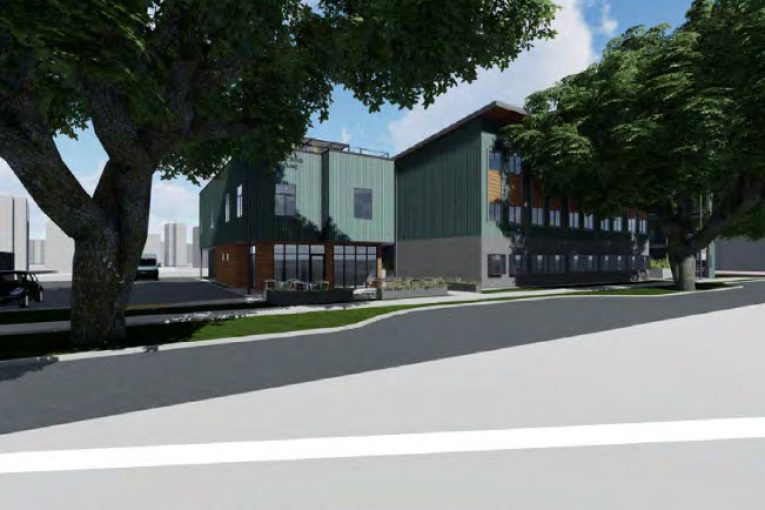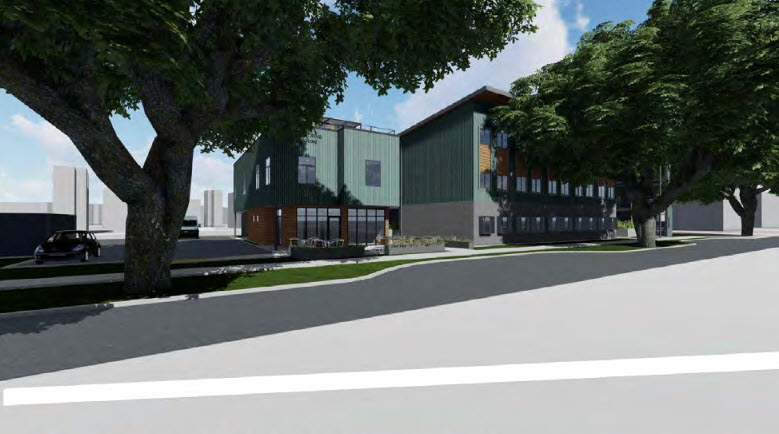
 By David M. Greenwald
By David M. Greenwald
Executive Editor
Davis, CA – There are a lot of interesting features of the Olive Drive Mixed-Use Project. At 47 units, all of them single bedroom, it is a small project. It is definitely not going to be a gamechanger for housing.
It does continue a trend whereby the city is moving toward housing that is not merely designed for students. This is the third project in the pipeline that is expressly for workforce housing rather than student housing—following the Chiles Apartments and the University Research Park Mixed-Use. If the voters approve DiSC 2022, that could be the fourth such housing component approved.
When student housing projects have come forward, critics have pointed out the need for workforce and family housing.
One interesting feature of this project is that it essentially has no parking on site. Immediately skeptics argue that people will simply stash their cars somewhere.
They probably aren’t going to do it nearby—if they do so at all. Olive Drive has limited parking. And while it is true you could park it in a lot, you can’t really keep it in a lot that would require it to be moved periodically.
One thought I had would be for the city to create some sort of car storage area for people who live in places without parking, who don’t need their cars on a regular basis. That would allow people to have vehicles but reduce their need to drive.
I have looked at data on vehicle ownership and, as we know, students who live in town have a very low percentage of access to vehicles. That number goes up though, once you get outside of the student market. For millennials between the ages of 20 and 38, for example, about two-thirds own vehicles. For the entire American population it is upwards of 90 percent.
In any case, given people’s concern for driving-centered development, this is the opposite—it is a project that, if it doesn’t completely eliminate driving, it at least discourages both car ownership and regular vehicle use.
That seems like a good idea—especially now as the price of gas is soaring and climate change is becoming ever more threatening to the future of humanity.
So those who argue that such a project may be more likely to attract students have a point.
The project doesn’t preclude students by any means.
As staff notes, “The proposed 47 units in place of four small sized single-family family homes plus the commercial and office component will revitalize the area and add diversity to the City’s housing stock. It is a reinvestment in the underutilized properties.”
They add, “The proposed project will contribute to the broad range of housing types and configurations in the City. It is an apartment complex not dedicated solely to students by providing smaller affordable and market-rate one-bedroom rental units oriented towards local workforce.
“The proposed project is predominantly a residential project that will contribute towards meeting the City’s housing needs. It will provide housing that could serve non-professional workers in the City,” staff adds.
Furthermore, it “provides for the opportunity to reduce vehicle miles travelled by placing residential units near the job producing non-residential uses and the surrounding commercial uses in the neighborhood.”
They are not going to exclude students—nor should they. What this does create is a small apartment that people other than students have the opportunity to inhabit. It’s not a project of 3-to-5-bedroom apartments.
My one qualm would be with the Social Services Commission pushing away from the 13 affordable units. That would have been 28 percent of the project as low-income housing perpetuity.
But it would have meant no extremely or very low-income units.
It’s a tradeoff. the Social Services Commission liked the project and its features, but “asked that we provide one very low-income unit and at least one extremely low-income unit.”
That request “stretched the ability of this provision.” So they changed their proposal to five low-income units along with one very low and one extremely low unit for a total of seven deed-restricted affordable units.
“We believe this will meet the recommendations of the Social Services commissions and provide the community with privately subsidized affordable housing,” the applicant wrote.
While I certainly understand the Social Service Commission’s thinking here, why not go big with 13 units (28 percent) and accept that it’s going to only serve low income rather than the two lower levels of income?
As the council and Planning Commission weigh back in, I hope they rethink this ask.







I’m sure you read the comments the other day about this. Why do you believe the project is EXPRESSLY for workforce housing rather than student housing. It seems that the project isn’t EXCLUSIVELY student housing. But as was said previously in the comments, who are the predominate non-professional renters in Davis?
Is there a mechanism that keeps the unit prices in the range of “workforce” housing?
If it were for student housing, why wouldn’t they have larger units where they could pack in more students?
There is no mechanism that I can see that would prevent students from living there, it even mentions the possibility.
My question wasn’t if there was a mechanism to prevent students from living there. Why would we prevent anyone from living anywhere? That’s probably illegal.
My question was if there was mechanism that controls the pricing of the units that keeps them affordable for those in a specified “workforce” income range? Or are they just market rate inexpensively priced units?
No there is no mechanism. Other than the “affordable” units, they are affordable by design.
No.
No. 🙂
Personally, I think the Vanguard should sponsor a contest to “guess the rent” (or sales price) of proposed developments, with some kind of prize for the winner.
Keith, one thing I’ve learned on here is that it doesn’t matter how many times you point out reality. David (and sometimes others) will then double-down, as a result. Must be something they teach in political science.
Someone else informed me that this proposal was originally acknowledged to be student housing, though I’m not sure if it had undergone any changes since then. Regardless, it seems that they’re going with the “non-professional workforce housing” description in order to sound more palatable. (Not sure why, as it would likely be approved regardless.)
No, other than the Affordable units.
Some students prefer, and can afford single units. Perhaps also with a “significant other”.
What makes you think that “non-professional, non-student workers” can afford to rent a unit on their own? And, would do so without a parking space available to them?
There won’t be one “non-professional, non-student worker” in the entire complex, other than perhaps in the Affordable units.
Kind of an ugly-looking building, which seems to be the trend these days.
That was a trick that our former president used as well.
Really interesting grey multi-story downtown structures in the graphic behind the proposed building.
I saw those, and thought it might be something from a futuristic movie set. Maybe that’s where the “future non-professional workers” will live – sort of like a Metropolis type movie situation.
I still don’t believe that there are large numbers of “non-professional, non-student” workers in the first place. Seems to me that most of them ARE students.
I don’t think anyone is denying that. It’s just a good sales pitch to say it *could* be used as workforce housing. Nothing to see here.
Well, I did see this in the article:
Ironically, I think this argument works against them (if anything), regarding the lack of parking.
I still think that of the three bicycle crossings proposed to/from that street (with one under construction), the only one that won’t be built is the one that’s most needed (across Richards, toward UCD).
The Richards/Olive intersection remains unimproved and dangerous. That is hasn’t been upgraded is on the City.
I’d be curious to see the current timeline for the corridor update, because the improvement of the intersection is part of that. Money is a huge factor for the city. Right now the city doesn’t have the funds to do such projects without grant funding.
One thing DG did not address is visitor parking. The problem is, there is little to do except try to get away with parking in a business or another residential unit’s parking and hope you don’t get caught, which you probably won’t. This could exacerbate parking issues in the area and needs to be addressed.
Five comment rule is in effect. Please monitor your own comment count.
David Greenwald:
Alan Miller:
Leaving aside the air and noise impacts on human health within a freeway zone – exacerbated by the nearby Diesel-y railway:
The proposed development is pretty good but mixing in families and more lower-income people would be better. The ability to park large bikes should be clear, there should be a parking district created for Olive that could NOT be used by residents at the project (mainly to reduce satellite parking possibilities for campus destinations.
Making it car-lite would be much easier – and it would work better – if transportation in the immediate – let’s call it the Richards-Olive-80-Railway-Campus-Downtown Clusterf*ck – was handled creatively and holistically. This would address features such as businesses which create more private vehicle trips that than the ‘Cluster*ck can handle, the intense lack of ambition in sustainability of the 80-Richards interchange project, lack of carshare possibilities for current residents of east Olive, free and cheap short-term parking in Downtown unnecessarily sucking vehicles up the sphincter of the undercrossing of the Union Pacific tracks and short-term blindness about the obvious risks to the City’s newest safe route to school by making Olive a detour for ALL WB 80 traffic wishing to access Downtown and In & Out.
Building parking in structures – necessary for this tight area – can cost upwards of $50,000 per space. That’s an obvious solution for visitors for any housing on Olive, and it should also enable the removal of all vehicle parking on Olive and other measures to make this route a great one between relatively nearby areas in East and South Davis (not only Montgomery ES), Olive, campus and eventually the train station.
How to justify the cost? Will people park here to access the Downtown with a free and frequent shuttle? If the parking structure on 1st between F and G is converted to a venue with a rooftop restaurant court and music, etc, will that bring in enough funding to help pay for the structure? If the structure is used to support a park & ride on I-80 for express buses to and from points east and west, can it receive funding as part of the 80 Managed Lanes Project? (Why is there apparently no plan to build park & rides in other part of Davis to enable express bus use of modifications to 80 in the Project?)
*It’s obvious to me that the chronic negative transportation impacts on Richards and Olive from the drive thru’s which impact people cycling and walking the most are overlooked because these places are huge sources of tax revenue. The 80-Richards interchange project may improve related safety impacts on the structure itself – i.e. egress points on 80 – but is less likely at Richards and Olive as there are no infrastructure modifications planned here that reduce trips by car to the drive-thru’s. There are no infrastructure modifications in the pipeline in any concrete way, only vague mention by Public Works staff of changes to Olive itself that might be considered after the interchange project is complete and the detour is closed.